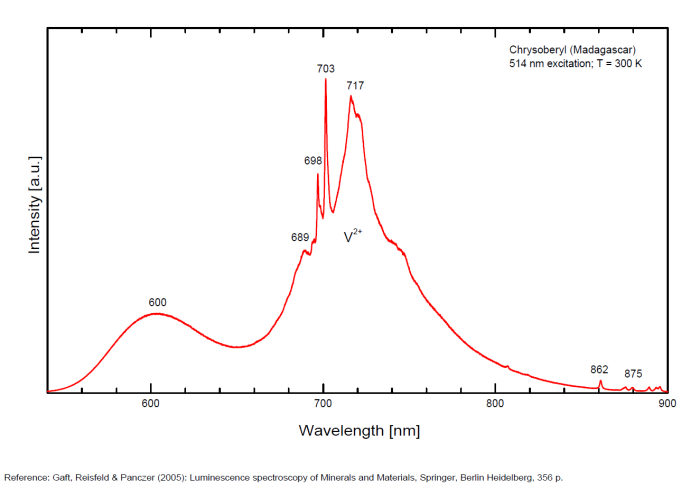Base de données des minéraux luminescents
CHRYSOBERYL
Formule chimique: BeAl2O4
Famille: Oxydes et Hydroxydes
Statut: IMA-GP
Système cristallin : Orthorhombique
Minéral de vitrine: NON
Noms associés (variétés luminescentes, noms discrédités, synonymes etc.): alexandrite,
Luminescence:
Couleurs UV longs (365nm): |
Rouge , | ||
Intensité OL:Très faible | |||
Couleurs UV moyens (320nm): |
Rouge , | ||
Couleurs UV courts (254nm): |
Rouge , Jaune vert , | ||
Intensité OC:Très faible | |||
Vous avez une photo de ce minéral que vous voudriez voir figurer dans la galerie? Contactez-nous!
Phosphorescence (au sens commun du terme) observable à l'oeil nu:
Aucune phosphorescence observable à l'oeil nu quelle que soit le type d'UV
Commentaires:
Varété alexandrite: fluorescence rouge due au chrome (Cr2+)
Chrysobéryl classique: jaune vert, crème, verdâtre;
Activateur(s) et spectre(s):
Activateur(s): Cr3+, V2+,
Pics dans le spectre (nm):
Cr3+ replacing Al : 678, 680 nm V2+ : band around 720 nm (80nm half-width) (Gaft), VO6 : broad band at 645nm (FWHM: 120nm) TiO6 : 516nm (FWHM: 115nm) (Gaft), band at 540 nm (Gorobets), 689, 698, 703nm (Gaft)

Spectrum: Michael Gaft, Petah Tikva, Israel. Plot: Institute of Mineralogy, University of Vienna, Austria, with permission of the authors.
Commentaires sur les spectres et les activateurs (*):
The Al3+ ions are octahedrally coordinated by the oxygen ions and occur in two not equivalent crystal field sites in the lattice. The Cr3+ ions replace substitutionally the Al3+ ions, 78 % replacing Al3+ ions in one position and the rest going into the second sites. The major features of the spectra at 300 K are the two sharp lines R1m (m for mirror, the first position for Al3+ replacement) and R2m peaking at 680 nm and a broad, structured band peaking at lower energies. The 689.5 and 695.2 nm decay time is much larger than that for the 677.9 and 679.5 nm emission (Suchoki et al. 1987). At certain excitation wavelengths, such as 488nm, the R1i (i for inversion) and R2i peaking at 690.0 and 695.0 nm lines associated with Cri ions in inversion sites (second site) appear (Powell et al. 1985) The Cr3+ luminescence properties in natural chrysoberyl minerals have been studied as a function of the Cr content as well as impurities such as Fe and V. A competition was found between Cr and V for very low Cr concentration with the vanishing of Cr3+ emission from Cr3+ ions located in inversion site. The Fe3+ ions substitute in mirror site efficiently with a strong impact on the Cr3+ lifetime of mirror site (Ollier et al. 2015). Cathodoluminescence: red;
(*)Les commentaires sur les spectres sont uniquement rédigés en Anglais
Meilleure(s) localité(s) pour la fluorescence (*):
- Takovaja River, Ural Mountains, Russia (var. Alexandrite fluo red);
- Izumrudnye Kopi area, Malyshevo, Sverdlovsk Oblast, Ural, Russia;
- Santa Teresa, Espirito Santo, Brazil (yellow SW);
- Haddam, Connecticut, USA (SW yellow green);
(*)Les données ne sont pas exhaustives et sont limitées à quelques localités remarquables pour la fluorescence
Référence bibliographique pour la luminescence:
- The Henkel Glossary of Fluorescent Minerals, Dr. Gerhard Henkel, Published by the FMS, 1989 ,
- Fluorescence: Gems and Minerals Under Ultraviolet Light, Manuel Robbins, 1994, Geoscience Press, ISBN 0-945005-13-X ,
- Luminescence Spectroscopy of Minerals and Materials, M. Gaft, R. Reisfeld, G. Panczer, Springer Editor, ISBN: 10 3-540-21918-8 ,
- Luminescent Spectra of Minerals, Boris S. Gorobets and Alexandre A. Rogojine, Moscow, 2002 ,
- Handbook of Fluorescent Gems and Minerals, a practical guide for the gem and mineral collector, Jack de Ment, 1949 ,
Référence minéralogique sur internet:
 http://www.mindat.org/show.php?name=Chrysoberyl
http://www.mindat.org/show.php?name=Chrysoberyl
 http://webmineral.com/data/Chrysoberyl.shtml
http://webmineral.com/data/Chrysoberyl.shtml
Recherche sur Internet:
 Recherche d'images sur 'Google Image'
Recherche d'images sur 'Google Image'
 Recherche de documents en français sur Google
Recherche de documents en français sur Google
 Recherche de documents en toutes
langues sur Google
Recherche de documents en toutes
langues sur Google
Une requête ne donnant pas de résultat signifie uniquement qu'aucune référence de ce type n'existe dans la base mais en aucun cas qu'elle n'existe pas dans l'absolu. Si vous considérez avoir trouvé une erreur ou une omission, merci de nous le signaler via la page contact en n'oubliant pas de citer la source de l'information.
